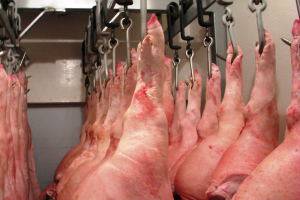Global meat production curbed due to disease, drought

Global meat production rose to 297 million tons in 2011, an increase of 0.8 percent over 2010 levels, and is projected to reach 302 million tons by the end of 2012 . By comparison, meat production rose 2.6 percent in 2010 and has risen 20 percent since 2001.
This is according to new research conducted for Vital Signs Online service.
Record drought in the U.S. Midwest, animal disease outbreaks, and rising prices of livestock feed all contributed to 2011’s lower rise in production.
Consumption
Also bucking a decades-long trend, meat consumption decreased slightly worldwide in 2011, from 42.5 kilograms (kg) per person in 2010 to 42.3 kg. Since 1995, however, per capita meat consumption has increased 15 percent overall; in developing countries, it increased 25 percent during this time, whereas in industrialized countries it increased just 2 percent. Although the disparity between meat consumption in developing and industrialized countries is shrinking, it remains high: the average person in a developing country ate 32.3 kg of meat in 2011, whereas in industrialized countries people ate 78.9 kg on average.
Pork was the most popular meat in 2011, accounting for 37 percent of both meat production and consumption, at 109 million tons. This was followed closely by poultry meat, with 101 million tons produced. Yet pork production decreased 0.8 percent from 2010, whereas poultry meat production rose 3 percent, making it likely that poultry will become the most-produced meat in the next few years.
A breakdown of meat production by geographic region reveals the dramatic shift in centers of production from industrialized to developing countries over the last decade. In 2000, for example, North America led the world in beef production, at 13 million tons, while South America produced 12 million tons and Asia, 10 million tons. By 2011, North America had lowered its beef output by 200,000 tons and was overtaken by both South America and Asia, which produced 15 million and 17 million tons, respectively.
Widespread and intense drought in China, Russia, the United States, and the Horn of Africa contributed to lower meat production—and higher prices—in 2010 and 2011. The combination of high prices for meat products and outbreaks of new and recurring zoonotic diseases in 2011 curtailed global meat consumption. Zoonotic diseases, or zoonoses, are diseases that are transmitted between animals and humans. In 2011 alone, foot-and-mouth disease was detected in Paraguay, African swine fever in Russia, classical swine fever in Mexico, and avian influenza (H5N1) throughout Asia. According to a 2012 report by the International Livestock Research Institute, zoonoses cause around 2.7 million human deaths each year, and approximately 75 percent of all emerging infectious diseases now originate in animals or animal products.
Many zoonotic disease outbreaks can be traced to concentrated animal feeding operations (CAFOs), also known as factory farms. These systems now account for 72 percent of poultry production, 43 percent of egg production, and 55 percent of pork production worldwide.
Factory farming systems contribute to disease outbreaks in several ways. They keep animals in cramped and often unsanitary quarters, providing a breeding ground for diseases; they feed animals grain-heavy diets that lack the nutrients needed to fight off disease and illness; and many CAFOs feed animals antibiotics as a preventative rather than a therapeutic measure, causing the animals—and the humans who consume them—to develop resistance to antibiotics.
But not all livestock are reared in industrial or mechanized environments. Nearly 1 billion people living on less than $2 a day depend to some extent on livestock, and many of these people are raising animals in the same ways that their ancestors did. Reconnecting meat production to the land and its natural carrying capacity, as well as reducing meat consumption, can thus greatly improve both public and environmental health.
Further highlights from the report:
• Production of both beef and sheep meat stagnated between 2010 and 2011, at 67 million and 13 million tons, respectively.
• Over the last decade, meat production grew nearly 26 percent in Asia, 28 percent in Africa, and 32 percent in South America.
• In 2012, drought and corn crop failures continue throughout the United States, causing the U.S. Department of Agriculture to estimate that by 2013, beef will cost 4–5 percent more than in 2010, pork 2.5–3.5 percent more, and poultry 3–4 percent more.







